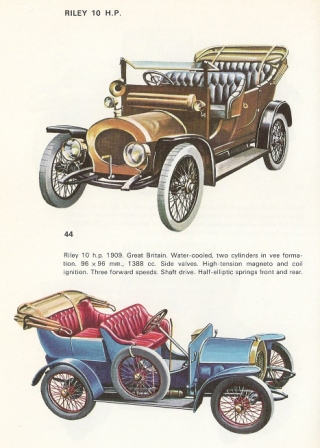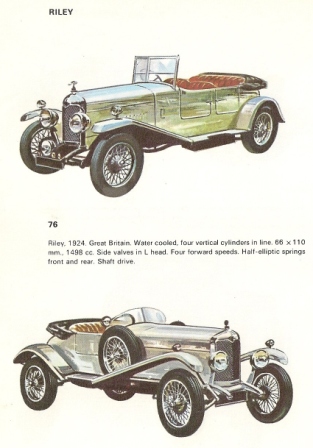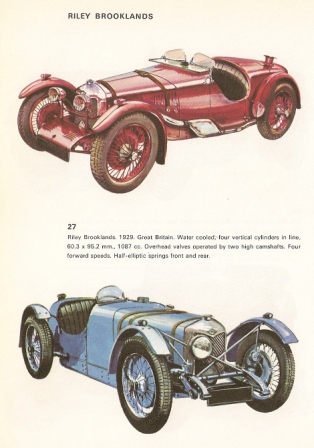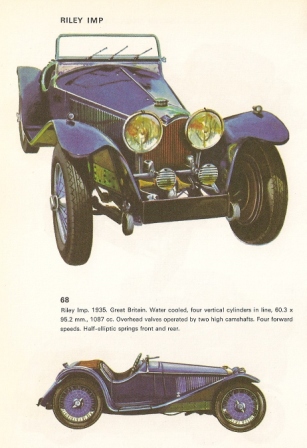Left - Imp print from a calendar and Right - Winner 1935 RAC Tourist Trophy Race on the Ards circuit
painting shows Freddie Dixon passing the Central Bar, (now the Elk Inn) Dundonald
from a Watercolour painting by Northern Ireland motoring artist "Mike.
1908 Riley Tourer 12/18
From "Vintage Motorcars"book 1970.
'Old Midnight' was what the employees at the Riley Cycle Company of Coventry christened their prototype 12-18hp model, introduced at the 1907 Olympia Exhibition, because its development had entailed so much overtime working.
The 12-18 was designed by the brothers Percy and Stanley Riley:
Percy had constructed his first motor car in 1896-8, having just left grammar school. He hand-filed the gears for this little voiturette himself, and fitted its single-cylinder engine with one of the earliest examples of a mechanically-operated
inlet valve: most early cars breathed through automatic inlets, in
which the suck of the piston pulled open the valve against the pressure
of a light spring.
The 12-18 was the logical successor to Riley's first production four wheeler, the 9hp of 1906, which followed a line of tricars of more or less motor cycle type. Like the 9hp, the 12-18 had a vee-twin engine and a constant-mesh gearbox, with the ratios selected by dog-clutches. In an era when few drivers could change gear on a conventional gearbox without a horrendous 'sidegrubbing of teeth', the silence and ease of the Riley change met with a good deal of favourable comment. Novel, too, was the use of detachable wheels: most cars had fixed wheels, which meant that the frequent punctures had to be dealt with in situ. Riley used their own design of detachable wheels, which was subsequently adopted by a number of other manufacturers: the 9hp was said to have been the first car to feature detachable wheels as a standard item of equipment.
The engine of the 12-18 had a bore of 102mm and a stroke of 127mm, giving a swept volume of 2113cc: it had a fairly effective system of pump-fed lubrication, fed from an oil tank under the bonnet. For its engine capacity, the 12-18 was no mean performer for its day: in May 1908 a four-seated example achieved 48mph over a flying kilometre on the private
speed course on the Duke of Portland's estate at Welbeck Abbey, and a
similar model won the Ballinaslaughter Hill Climb and made a virtual non-stop run in the Irish Reliability Trials of 1908.
The 12-18 was available with either 'short' or 'long' chassis. The former sold for 225 guineas in two-seater and 235 guineas in four-seater form, and had an 8ft wheelbase. The 'long' with a 9ft wheelbase, cost £283 with five-seated 'rotund' coachwork.
With their ovoid radiator and well-designed bodywork, the 12-18 Riley and its smaller sibling, the 10hp, introduced for 1908, were among the more handsome light cars of their day, and really laid the foundations for Riley's reputation as makers of high-quality cars of moderate capacity. It is difficult to see in them the genesis of the successful and much-loved Riley Nine of 1927 - which did so much to establish the image of the high-performance, economical light car: but the same designers were responsible for the later model, too.
From rear of print - V-twin
engine, 102mm by 127mm; 2075cc, 12.9hp; three-speed gearbox and
reverse; HT magneto; semi-elliptic springs front and rear.
©1967 National Magazine Co. Ltd. Drawn exclusively for CAR by Peter Griffin from the original in the Herbert Art Gallery and Museum, Coventry.
Left - 1929 Riley 9 Brooklands print by Parsons, this is number 25 of a set, information is printed on the back. and right - a nice black and white print of an Imp.
Cars of the World in colour , a series of 7 books from Blandford press published between 1969 and 1975.
Below - 2 x prints of the 5 Rileys to feature in these books.





The above Riley Brooklands card, blank inside is also available as a limited edition print by the artist Chris Dugan from
"The Motoring Man" 20 Hurn Road, Ringwood, Hants, BH204 2AF, Tel. 01425 479388, email motoring-man@hotmail.co.uk
Above - a cutout print from the comic "Eagle" February 1962 and a rather good 1936 Sprite print.
Above - A vintage rally scene by talented artist Vaclav Zapadlik, could not find a dedicate website but this one has some details -
A couple of RM's and a 1927/28 Riley print by Hobby, for sale on ebay.
A nice black and white print of a 1933 Monaco saloon and 1934 MPH.
Not sure where from but a different marque for each month, the Riley for May enlarged.
Left - Freddie Dixon white Riley print, centre - at Brooklands 1934 and right - print of a 4/72 advert.